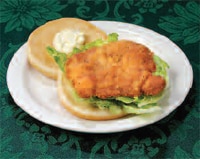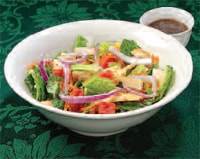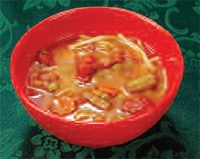Energy balance - Understanding this concept is important to successful
weight loss, gain or maintenance. So,
here’s a brief review: if you consume more calories than you burn, you will
gain weight. If you burn more calories than you consume, you will lose weight.
However, a big caveat: while a calorie is a calorie, the nutrients you consume
affects metabolic and hormonal secretions which may cause you to store fat
instead of utilize the fat for energy, and vice versa. The types and
varieties of food and beverages you ingest effect weight management, but more importantly, they are essential to your total wellness.
Understanding caloric need - Exercise is a variable that increases caloric expenditure and
metabolism. In order to determine an estimation of the calories you need to consume to gain, maintain or lose weight, it's helpful to calculate your total daily
energy expenditure (TDEE). You can use the calculator found here, which calculates basal metabolic rate (BMR) using the Mifflin-St Jeor
equation, and then applies an activity multiplier. It's best to underestimate your acitivity level when using the calculator if you're looking to lose weight because this puts you on the conservative side of daily caloric needs. Then, if you want to calculate how many calories you should eat daily to achieve weight loss at a steady, healthy pace, you subtract
15-20% from your TDEE number. Conversely, if you're looking to gain weight, add 15-20% to the TDEE. It's not recommended
that you subtract more than 25% from your TDEE calculation. You don’t want your
calorie intake to drop to an unhealthy and unsustainable level.
The amount of calories you eat is important, but not the whole picture in a healthy diet. Good nutrition includes a balance in the macronutrients listed below and the way you accomplish this is in the way you combine the foods you eat in a meal. For example, rice and beans. These two foods are considered a complete protein when eaten together. If you're a vegan. In general, try to get your total daily caloric intake from a variety of whole foods as follows:
- Protein: 1 gram per pound of body weight
- Fat: .45 grams per pound of body weight
- Carbs: The remaining number of calories left will be filled with carbs
Nature counts the calories – Back to our discussion of low
energy dense foods and how they help with weight loss. It seems Mother Nature really does know best
because “foods with a lower energy density actually provide fewer calories per
gram than foods with a higher energy density (CDC).” Also, low energy dense foods are typically more
nutrient dense. Nutrient density is a measure of the nutrients provided per calorie
of food, or the “ratio of the amount of a nutrient in foods to the energy
provided by these same foods (Nestle).”
So, it’s a win/win situation when you choose low energy/high
nutrient dense foods because not only do they contribute fewer calories to the
energy balance equation, they also provide greater nutritional value per
calorie, which is especially beneficial for our health. These foods are
the best of both worlds so to speak.
Let’s
look at a simple example of a higher nutrient/lower energy density food and a lower nutrient/higher energy dense food containing the same amount of calories per serving:
Nutrient
Dense
|
Energy
Dense
|
|
171
calories/serving
|
2 wedges
of watermelon (approximately 1/8 of a whole watermelon)
|
14 ounces
of Dr. Pepper
|
Nutritional
Facts
per
serving
|
Calories 171
Calories from Fat 7
Total Fat 0.743g
Saturated Fat 0.371g
Polyunsaturated Fat 0.371g
Monounsaturated Fat 0.371g
Cholesterol 0mg
Sodium 7mg
Potassium 636mg
Carbohydrates 43.086g
Dietary Fiber 2.229g
Sugars 35.286g
Protein 3.343g
Vitamins
& Minerals:
Vitamin A 67% · Vitamin C 78%
Calcium 4% · Iron 7%
|
Calories 175
Calories from Fat 0
Total Fat 0g
Saturated Fat 0g
Polyunsaturated Fat 0g
Monounsaturated Fat 0g
Cholesterol 0mg
Sodium 70mg
Potassium 0mg
Carbohydrates 46.2g
Dietary Fiber 0g
Sugars 44.8g
Protein 0g
|
Arguably, it might not seem equitable to compare a beverage with a food, but watermelon is 91% water by weight, so it's not too biased of a comparison. Remember, we are comparing identical calories per serving here. The numbers speak for themselves. If I’m trying to consume fewer calories in an effort to lose weight, watermelon is the better food choice by far. Where’s the Vitamin A and C in the soda? The numbers indicate a lot of sugar, no fiber or protein. The soda simply contains what are referred to as "empty calories" which provide energy, but no nutrition. So after I drink my soda my body gets an injection of simple sugars and a blast of salt. Ironically, the salt can make me thirsty and this leads me to drink another soda later, but that's for another post!
On the other hand, the 2 wedges of watermelon provide 67% of the
daily requirement of Vitamin A and 78% of Vitamin C. That’s some good stuff! Plus, the 2.3 grams
of fiber in the watermelon will help me feel fuller for a longer period of time
than the soda, which has 0 grams of fiber. I might even feel full after eating 1
wedge of watermelon. Therefore, I can eat less of this food and decrease my
calorie intake while keeping my hunger satisfied for longer than I could with a
soft drink. This brings me to my next point, which can be pivotal to weight loss
success.
Eat more to lose weight? – Really?! Usually losing weight is equated with starving oneself and eating minuscule portion sizes, right? However, foods with a low energy/high nutrient density typically contain fewer calories per serving than the same amount of a high energy/low nutrient density food and they provide more vitamins, minerals and also phytochemicals. You can read more about phytochemicals and their amazing health benefits here.
Now, let’s look at another example comparing the
nutritional information for servings of an nutrient dense food with a calorie dense food, but of differing calorie content:
Nutrient
Dense Food
|
Energy
Dense Food
|
|
Food
choice
|
Kale
|
French Fries
|
Calories
per serving
|
1 cup
chopped
33
calories
|
1 medium
serving (117 g)
365
calories
|
Nutritional
facts per serving
|
Total Fat
0.6 g
Saturated
fat 0.1 g
Polyunsaturated
fat .2 g
Monounsaturated
fat 0 g
Cholesterol
0 mg
Sodium 25
mg
Potassium
329 mg
Total
Carbohydrate 6 g
Protein 2.9
g
Vitamin A 133%
Vitamin C 134%
Calcium 10%
Iron 5%
Vitamin D 0%
Vitamin
B-6 10%
Vitamin
B-12 0%
Magnesium 7%
|
Total Fat
17 g
Saturated
fat 2.7 g
Polyunsaturated
fat 6 g
Monounsaturated
fat 7 g
Trans fat
0.1 g
Cholesterol
0 mg
Sodium 246
mg
Potassium
677 mg
Total
Carbohydrate 48 g
Dietary
fiber 4.4 g
Sugar 0.4
g
Protein 4
g
Vitamin A 0%
Vitamin C 9%
Calcium 2%
Iron 5%
Vitamin D 0%
Vitamin
B-6 20%
Vitamin
B-12 0%
Magnesium 10%
|
Once again, the data doesn’t lie. As the above comparison shows, I would
have to eat a whopping 11 cups of chopped kale to equal the amount of calories I would
consume in a medium serving of fries! If I’m trying to lose weight, the good news is that I can eat more kale while consuming far fewer calories than I would if I were to eat the French fries. This means I will feel fuller for a longer period of
time. I’m also fueling my body with less unhealthy fats and far more
nutritional value. Like I said before, it’s a win/win.
Move over vegetarian, I'm a nutritarian - So are you ready to transition to a nutritarian diet which is eating more low-energy/nutrient
dense foods? If you said yes, congratulations! You're making a good choice for your health. Are you unsure how to decide which foods to choose? A good starting point to help you in your search to find the most nutrient dense foods is
to check out the ANDI guide. ANDI stands for aggregate nutrient density index
and was developed by Dr. Joel Furhman.
This is from Dr. Furhman's site: "Adequate consumption of micronutrients – vitamins, minerals, and many other phytochemicals – without overeating on calories, is the key to achieving excellent health. Micronutrients fuel proper functioning of the immune system and enable the detoxification and cellular repair mechanisms that protect us from chronic diseases. A nutritarian is someone whose food choices reflect a high ratio of micronutrients per calorie and a high level of micronutrient variety."
With this in mind, the ANDI guide categorizes whole foods and then scores them on a scale from 1 to 1000 based on an extensive range of micronutrients, including vitamins, minerals, phytochemicals and antioxidant capacities. In addition, Dr. Furhman's original ANDI guide has been updated to reflect a more accurate picture of each food's nutritional qualitywhich now considers certain beneficial phytochemicals, such as angiogenesis inhibitors (i.e. cancer prevention, read more here), organosulfides (found in onion, garlic and cruciferous veggies), isothiocyanates (organosulfur compounds found in cruciferous veggies and are among the most effective cancer-prevention agents known), and aromatase inhibitors (suppress the synthesis of estrogen and thought to aid in the prevention of breast cancer).
The ANDI guide can be a useful tool in your determining healthy food choices, but it isn't the holy grail. I like what Dr. Furham says and I believe his suggestion is the best advice when it comes to choosing foods. He says: “…nutrient density scoring is not the only factor that determines health benefits… if we ate only foods with a high nutrient density score, our diets would be too low in fat. For that reason we have to pick some foods with lower nutrient density scores.” Also, he notes that if thin individuals or those who are very active ate only foods with the highest nutrient density, they would become so full from fiber that it's likely they would be unable to meet their caloric needs. Remember my kale example above? One can only eat so much fiber. Balance and variety are key to consuming the greatest number and variety of micronutrients.
This is from Dr. Furhman's site: "Adequate consumption of micronutrients – vitamins, minerals, and many other phytochemicals – without overeating on calories, is the key to achieving excellent health. Micronutrients fuel proper functioning of the immune system and enable the detoxification and cellular repair mechanisms that protect us from chronic diseases. A nutritarian is someone whose food choices reflect a high ratio of micronutrients per calorie and a high level of micronutrient variety."
With this in mind, the ANDI guide categorizes whole foods and then scores them on a scale from 1 to 1000 based on an extensive range of micronutrients, including vitamins, minerals, phytochemicals and antioxidant capacities. In addition, Dr. Furhman's original ANDI guide has been updated to reflect a more accurate picture of each food's nutritional qualitywhich now considers certain beneficial phytochemicals, such as angiogenesis inhibitors (i.e. cancer prevention, read more here), organosulfides (found in onion, garlic and cruciferous veggies), isothiocyanates (organosulfur compounds found in cruciferous veggies and are among the most effective cancer-prevention agents known), and aromatase inhibitors (suppress the synthesis of estrogen and thought to aid in the prevention of breast cancer).
The ANDI guide can be a useful tool in your determining healthy food choices, but it isn't the holy grail. I like what Dr. Furham says and I believe his suggestion is the best advice when it comes to choosing foods. He says: “…nutrient density scoring is not the only factor that determines health benefits… if we ate only foods with a high nutrient density score, our diets would be too low in fat. For that reason we have to pick some foods with lower nutrient density scores.” Also, he notes that if thin individuals or those who are very active ate only foods with the highest nutrient density, they would become so full from fiber that it's likely they would be unable to meet their caloric needs. Remember my kale example above? One can only eat so much fiber. Balance and variety are key to consuming the greatest number and variety of micronutrients.
You may already know that kale is a better food choice
than French fries, so if you operate on the simple premise that your diet
should emphasize fruits, vegetables, and whole grains and not prepackaged, processed or fast food, you probably don’t need
the ANDI guide to tell you where to get the most nutritional bang for your
buck. However, if you’re uncertain as to whether or not you’re making the best
food choices for your health, the ANDI rankings are a good starting point.
I really like Dr. Weil's anti-inflammatory "diet" approach and I have incorporated some of his wisdom into my lifestyle as well. I've blogged about the health benefits of reducing the risk for chronic inflammation in an earlier post. Look for more on that in a future post. In the meantime, I'll leave you with this food for thought:
Sources:
- CDC Low energy dense foods and weight management - http://www.cdc.gov/nccdphp/dnpa/nutrition/pdf/r2p_energy_density.pdf
- Nutrient Density, Clemson Cooperative Extension - http://www.clemson.edu/extension/hgic/food/nutrition/nutrition/dietary_guide/hgic4062.html
- Food and Nutrition, Nutrient Density - http://www.nestle.com/asset-library/Documents/Library/Documents/Nutrition_Health_Wellness/Food-and-Nutrition-Issue09-Nutrient-Density-Jan2008.pdf
- Sports Science Exchange, Energy Balance and Weight Reduction - http://www.uni.edu/dolgener/UG_Sport_Nutrition/Articles/Energy_Balance.pdf
- Simple Science Fitness, Energy balance and law of thermodynamics -http://simplesciencefitness.com/
- Whole Foods Market uses ANDI guide - http://www.wholefoodsmarket.com/healthy-eating/andi-guide
- Nutrient Rich, ANDI Guide - http://www.nutrientrich.com/1/aggregate-nutrient-density-index-andi-score.html













